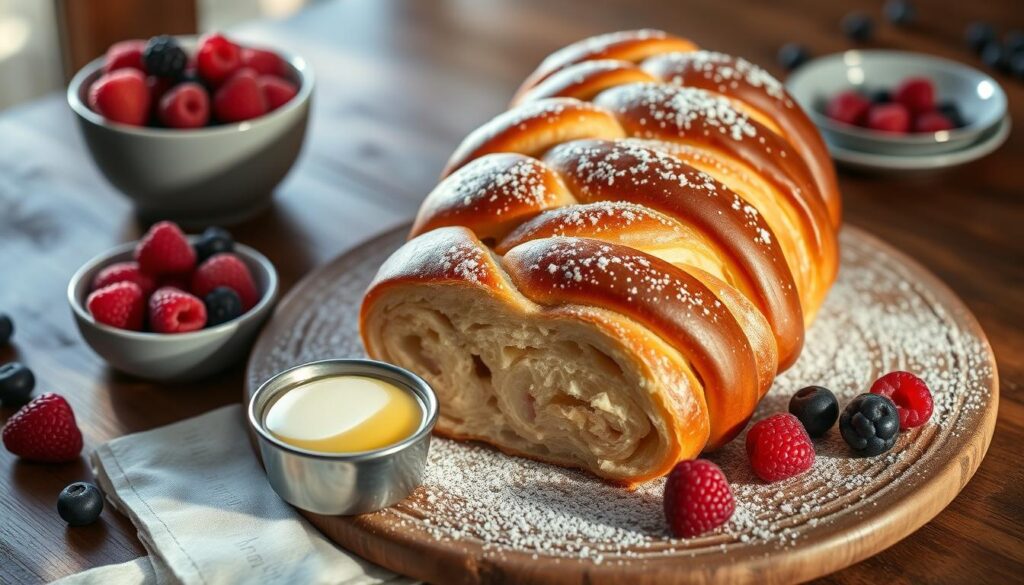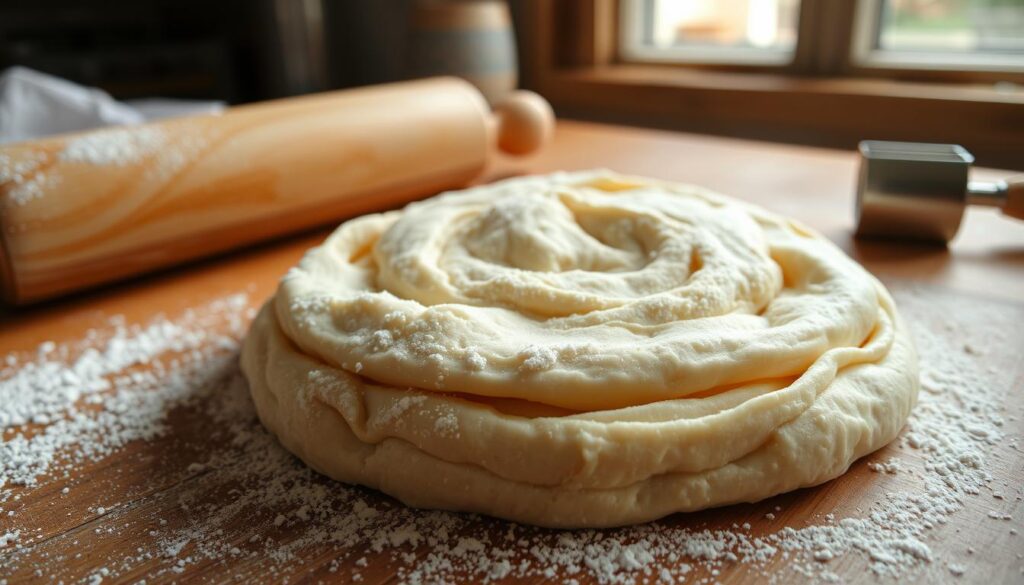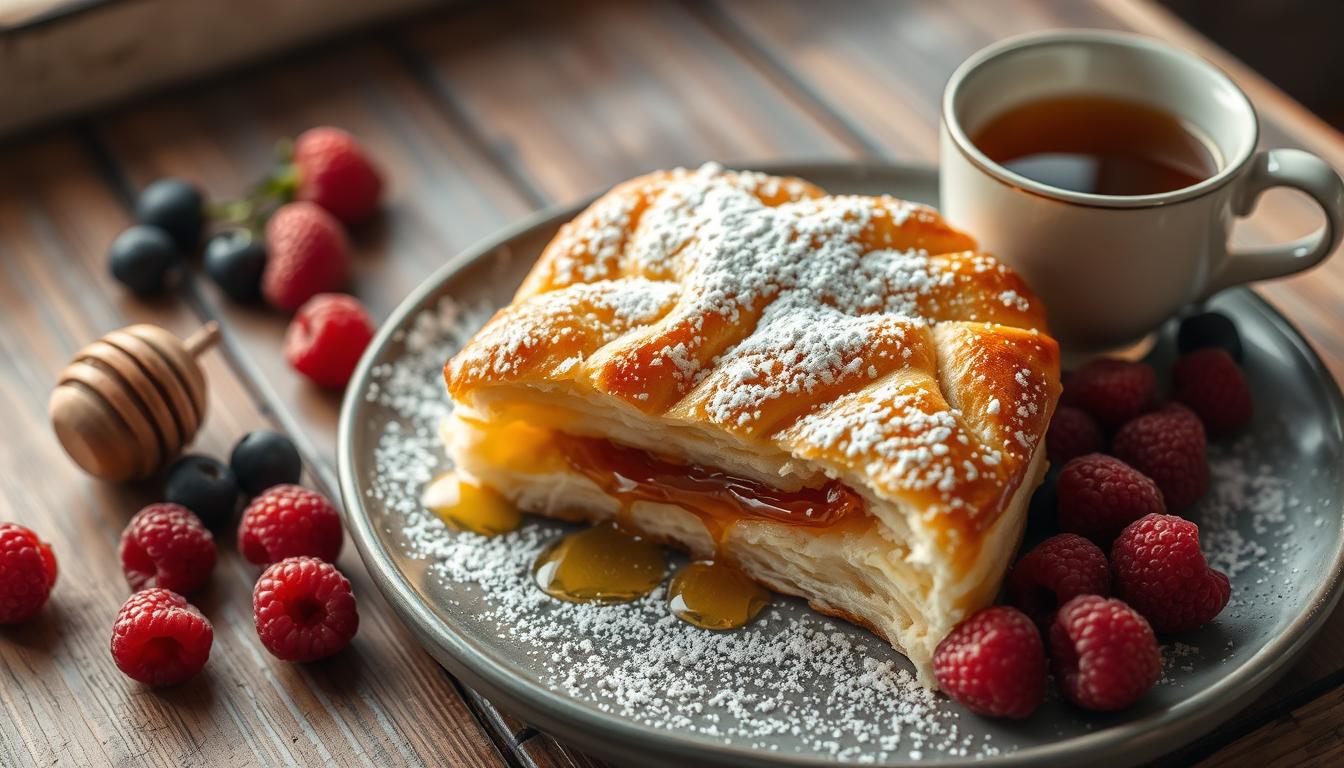As you walk through the Swiss streets, you can’t help but notice the smell of swiss butter braid recipe. It’s a scent that invites you to try a classic Swiss treat. The traditional gipfeli dough is a key part of Swiss swiss bakery pastries tradition. It’s loved by many, enjoyed at breakfast and in cafes.
In this article, we’ll dive into the story of this Swiss favorite. We’ll also share a delicious recipe. It will bring a taste of Switzerland right to your table.
Key Takeaways
- Gipfeli is a Swiss pastry similar to croissants, but with unique characteristics
- It has a long and rich history, rooted in Swiss baking traditions
- Gipfeli is a beloved breakfast staple and cultural icon in Switzerland
- The recipe requires specific techniques, such as dough lamination, to achieve the perfect texture
- With the right ingredients and methods, you can recreate the authentic Swiss gipfeli experience at home
What Makes Swiss Gipfeli Different from French Croissants
The gipfeli and French croissant may look similar at first. But they have key differences that make them unique. The main difference is in their shape and texture.
The Swiss gipfeli has a rounded, triangular shape. This shape gives it a golden crispy outside and a buttery gipfeli breakfast taste. It’s flakier than a croissant, making it lighter and airier.
Swiss bakers use more high-quality butter in the gipfeli dough. This makes the gipfeli taste richer and more indulgent. This focus on quality is a big part of Swiss baking.
| Feature | Swiss Gipfeli | French Croissant |
|---|---|---|
| Shape | Rounded, triangular | Crescent-shaped |
| Texture | Flaky, airy | Dense, doughy |
| Butter Content | Higher | Lower |
| Flavor Profile | Richer, more indulgent | Less buttery |
The Swiss gipfeli is a special breakfast treat. It’s a great choice if you want something different from the French croissant.

“The Swiss gipfeli is a true testament to the country’s renowned baking expertise, combining traditional techniques with the finest ingredients for an unforgettable breakfast experience.”
The History and Cultural Significance of Swiss Gipfeli
The origins of traditional gipfeli dough go back to Switzerland’s rich baking traditions. These swiss bakery pastries have been a favorite on breakfast tables for years. Each region in Switzerland has its own special way of making them.
Origins in Swiss Baking Tradition
Gipfeli, a croissant-like pastry, has been loved in Swiss cuisine for centuries. The recipe likely came from the French croissant of the 18th century. But Swiss bakers made it their own, creating a flakier, butterier treat that’s a national favorite.
Modern-Day Significance in Swiss Cuisine
Today, traditional gipfeli dough is still dear to Swiss people. These tasty swiss bakery pastries are more than just breakfast. They’re a key part of Switzerland’s food heritage. Enjoyed with Swiss coffee, they make the perfect morning.
Regional Variations Across Switzerland
- In the north, gipfeli have a richer, more indulgent dough, sometimes with extra butter or eggs.
- In the southern Swiss Alps, the pastries are a bit more savory, with herbs or spices added to the traditional gipfeli dough.
- Across the country, gipfeli shapes and sizes vary, from the classic crescent to intricate braids.
Despite their differences, swiss bakery pastries like gipfeli are a cherished part of Swiss food culture. They show off the country’s rich baking history and the lasting charm of this delightful treat.

Essential Ingredients for Authentic Gipfeli Recipe
Making the perfect Swiss gipfeli needs the right ingredients. From flour to butter temperature, every detail matters. They all help get the traditional gipfeli texture and taste right.
Selecting the Right Flour Type
For a real gipfeli recipe, use high-quality, all-purpose flour. Look for flour with 10-12% protein. This gives the dough the right mix of strength and softness. Don’t use bread or pastry flour, as they can make the dough too thick or too thin.
Butter Quality and Temperature
The swiss butter braid recipe needs top-notch, European-style butter with 82% butterfat. This butter is key for the flaky layers of a gipfeli. Also, make sure the butter is at 60-65°F (15-18°C) for the best lamination.
Additional Key Components
- Active dry yeast or fresh yeast for leavening
- Granulated sugar to enhance flavor and promote browning
- Salt to balance the sweetness and accentuate the other flavors
- Milk or water to hydrate the dough
- Egg wash (optional) for a shiny, golden-brown finish
With these key ingredients, you’re on your way to making authentic, Swiss-inspired gipfeli. They’re sure to please your taste buds.
Tools and Equipment You’ll Need for Baking
To make perfect Swiss gipfeli pastries, you need the right tools and equipment. Whether you’re experienced or new to gipfeli baking instructions, knowing the essential tools is key. Here’s what you need for baking tasty swiss bakery pastries.
- Rolling Pin: A sturdy rolling pin is crucial for rolling out the dough right. It helps get the flaky, layered texture that gipfeli are known for.
- Pastry Brush: A good pastry brush is needed for applying egg wash or glazes. It makes the gipfeli golden and shiny.
- Baking Sheets: Get heavy-duty, non-stick baking sheets for baking gipfeli. They ensure even cooking and prevent sticking.
- Stand Mixer: A strong stand mixer with a dough hook attachment makes kneading and lamination easy. It saves time and effort.
- Parchment Paper: Use parchment paper on your baking sheets. It prevents gipfeli from sticking and makes cleanup easy.
- Bench Scraper: A bench scraper is vital for handling the delicate dough. It helps during shaping.
- Cooling Rack: After baking, use a cooling rack. It lets the gipfeli cool without getting soggy.
With these tools and equipment, you’re ready to master gipfeli baking instructions. You’ll make delicious, flaky Swiss pastries. They’ll impress everyone and satisfy your taste buds.
Step-by-Step Gipfeli Recipe for Perfect Results
Making Swiss gipfeli is a fun and rewarding task. It needs some skill and care. Whether you’re experienced or new, these steps will help you make delicious gipfeli at home.
Preparing the Dough Base
Start by mixing the basic ingredients for the dough. You’ll need flour, salt, sugar, yeast, and cold water. Knead the dough until it’s smooth and elastic. Then, cover it and chill it in the fridge for at least 30 minutes.
Lamination Process
The lamination process is key for flaky layers. Roll out the chilled dough into a rectangle. Place cold, high-quality butter in the center. Fold the dough over the butter and roll it out again.
Keep folding and rolling several times. This builds the delicate layers.
Shaping Techniques
- After lamination, divide the dough into equal parts.
- Roll each piece into a long, thin rectangle.
- Roll the dough into a crescent shape from the long side.
- Curl the ends inward to form the classic gipfeli shape.
- Place the shaped gipfeli on a parchment-lined baking sheet, leaving space between each one.
By following these steps, you’ll make your own golden, flaky Swiss gipfeli.
Mastering the Art of Dough Lamination
The art of dough lamination is key to making the flaky, buttery layers of Swiss gipfeli. This process of folding butter into the gipfeli dough makes it different from the French croissant. Learning this technique is essential for a perfect swiss butter braid recipe.
The goal is to make thin layers of dough and butter. These layers will rise and bake into a flaky texture. The right amount of butter is important. Too much makes it greasy, too little makes it dry.
- Start by rolling out the chilled traditional gipfeli dough into a rectangle.
- Put thin slices of cold, high-quality butter over the dough, leaving a border.
- Fold the dough in half over the butter and roll it back out to the original size.
- Keep folding, rolling, and adding butter until the butter is evenly spread without overworking the dough.
- Finally, shape the dough into gipfeli, let it proof, and bake until perfect.
Keeping the dough and butter cold is crucial. If they get too warm, the layers will merge, ruining the flaky texture. Chilled dough and surfaces are key for a successful swiss butter braid recipe.
“Mastering the art of dough lamination is the key to unlocking the true essence of the Swiss gipfeli.”
With practice and focus, you can master lamination and make the flaky gipfeli you dream of. Be patient and precise, and you’ll enjoy a wonderful Swiss pastry experience.
Tips for Achieving the Perfect Golden Crispy Exterior
Baking the perfect golden crispy gipfeli is an art that needs careful attention. Each step, from temperature to proofing, is key for that perfect crunch and shine. Here are the main tips to help you get it right.
Temperature Control
Keeping the right temperature is crucial for a golden crispy gipfeli exterior. First, make sure your oven is at the right temperature, usually 400-425°F (200-218°C). This high heat helps the pastry rise and get a crisp crust.
Proofing Guidelines
- Let your dough proof at room temperature for 30-60 minutes. This step is vital for the golden crispy gipfeli texture.
- Don’t over-proof, as it can make the dough collapse and result in a dense pastry.
Baking Environment Factors
The baking environment greatly affects your gipfeli. Make sure your oven is well-preheated and keeps a steady temperature. Using a baking stone or steel can help achieve a professional crust.
Also, think about your kitchen’s humidity. Dry air helps your golden crispy gipfeli get crisper. You might want to open a window or use a dehumidifier while baking.
“The key to achieving that perfect golden crispy gipfeli is a combination of precise temperature control, careful proofing, and attention to the baking environment.”
Common Mistakes to Avoid When Making Gipfeli
Making the perfect gipfeli, a Swiss favorite, needs care and precision. Even skilled bakers can make mistakes that ruin the pastry. Knowing these errors helps you make better gipfeli.
One big mistake is overworking the dough. Too much kneading makes the gipfeli tough and chewy. Instead, gently mix the dough until it just comes together.
Another mistake is improper butter temperature. Cold butter doesn’t mix well, causing uneven layers. Make sure your butter is soft but still cool for the best results.
- Overworking the dough
- Improper butter temperature
- Insufficient proofing time
Lastly, underproofing the dough is a big error. Letting the dough proof long enough is key for a light texture. Wait until it doubles in size, as the traditional recipe suggests.
| Common Mistake | Solution |
|---|---|
| Overworking the dough | Handle the dough gently and only until it comes together, allowing the gluten to develop naturally. |
| Improper butter temperature | Ensure the butter is at the right temperature, softened but still cool to the touch, for optimal incorporation during lamination. |
| Insufficient proofing time | Allow the dough to proof until it has doubled in size, as per the traditional gipfeli dough instructions. |
By avoiding these common mistakes and following the gipfeli baking instructions, you can improve your pastry skills. Enjoy the delicious homemade Swiss gipfeli you’ll make.
Sweet and Savory Filling Variations
Swiss gipfeli fillings are as varied as Switzerland’s regions. You can find everything from almond paste or chocolate to new flavors. These pastries are perfect for breakfast or a snack.
Traditional Swiss Fillings
Swiss gipfeli fillings have been loved for ages. The nussgipfel, filled with almond paste, is a favorite. It pairs well with the buttery gipfeli outside.
Another classic is the chocolate-filled gipfeli. It’s filled with chocolate ganache or hazelnut spread. This makes the pastry even more delicious.
Modern Flavor Combinations
Swiss bakers are now trying new things with gipfeli. They’ve added flavors like aged cheese or prosciutto. They’ve also used sweet fillings like fruit or citrus creams.
These new flavors bring a fun twist to gipfeli. They show how versatile this Swiss treat can be.
Whether you like the old favorites or the new tastes, gipfeli is a Swiss favorite. Enjoy the flaky, rich pastry and explore the creativity it inspires.
Storing and Reheating Your Swiss Gipfeli
Keeping your Swiss gipfeli fresh is important. You want to enjoy their buttery taste and flaky texture for days. Here are some easy tips for storing and reheating your gipfeli.
To store them short-term, place your gipfeli in an airtight container. Keep it at room temperature for up to two days. This way, they stay crisp on the outside and soft inside.
When you’re ready to eat them, reheat them in a 350°F oven. Heat them for 5-7 minutes until they’re warm and crispy again.
If you want to store them longer, freeze your gipfeli. Put them on a baking sheet and freeze until solid. Then, put them in an airtight container or bag. Frozen gipfeli can last up to three months.
To reheat, put them on a baking sheet and bake at 375°F. Heat them for 10-12 minutes until they’re crispy and warm.
FAQ
What makes Swiss gipfeli different from French croissants?
Swiss gipfeli and French croissants are both buttery pastries. But, gipfeli are shaped like crescents and have a flakier texture. They also have more butter, which makes them taste and feel different.
What is the history and cultural significance of Swiss gipfeli?
Gipfeli have been a part of Swiss baking for centuries. They are a key part of Swiss cuisine and hold cultural value. Each region in Switzerland has its own twist on gipfeli, showing the country’s diverse flavors.
What are the essential ingredients for an authentic gipfeli recipe?
To make real Swiss gipfeli, you need quality ingredients. This includes flour, butter, yeast, sugar, and salt. The type of flour and butter temperature are key for the right taste and texture.
What tools and equipment are needed for baking gipfeli?
You’ll need a few tools to bake gipfeli. These include a rolling pin, pastry brush, baking sheets, and a stand mixer. These help with dough preparation, butter lamination, and shaping the pastries.
What are the steps for making the perfect gipfeli?
Making gipfeli involves several steps. First, you prepare the dough. Then, you laminate the butter into the dough. Finally, you shape the pastries. Paying attention to temperature, proofing, and baking is crucial for the perfect gipfeli.
How can I master the art of dough lamination for gipfeli?
Lamination is key for gipfeli. It involves folding butter into the dough to create flaky layers. Keeping the right butter-to-dough ratio and controlling temperature are important. With practice, you can get the perfect gipfeli texture.
What tips can you provide for achieving the perfect golden, crispy gipfeli exterior?
For a golden, crispy gipfeli exterior, use precise temperature control and proper proofing. Egg wash and adjusting baking times and temperatures also help. These steps ensure the signature look and texture of Swiss pastries.
What common mistakes should I avoid when making gipfeli?
Avoid overworking the dough and using butter at the wrong temperature. Also, make sure to allow enough proofing time. Following these tips helps ensure your gipfeli turn out perfectly every time.
What are some sweet and savory filling variations for gipfeli?
You can enjoy gipfeli plain or with powdered sugar. But, you can also try sweet fillings like almond paste, chocolate, or hazelnut spreads. For something different, try cheese, ham, or savory herbs and spices.
How should I store and reheat my freshly baked gipfeli?
Store gipfeli at room temperature in an airtight container for up to two days. Freeze them for longer storage. To reheat, use the oven or toaster oven to bring back their crisp, buttery texture.
What Is a Gipfeli Recipe?
A Gipfeli Recipe refers to the method of making Swiss-style croissants. These buttery, flaky pastries are similar to French croissants but often have a slightly denser texture and are enjoyed as a staple breakfast item in Switzerland.
How Do You Make a Traditional Gipfeli Recipe?
To make a traditional Gipfeli Recipe, you’ll need flour, butter, milk, yeast, and a pinch of sugar. The dough is laminated with butter, rolled into crescents, and baked until golden brown. The result is a flaky and delicious pastry perfect for any occasion.
What Is the Difference Between Gipfeli and Croissants?
The primary difference between a Gipfeli Recipe and a croissant recipe is the texture. Gipfeli tend to be slightly denser and less buttery compared to French croissants, offering a more subtle flavor while still being flaky and soft.
Can You Fill Gipfeli with Sweet or Savory Ingredients?
Yes, you can fill Gipfeli with various ingredients. Popular sweet fillings include chocolate, jam, or almond paste, while savory options might include cheese, ham, or spinach. The versatility makes them perfect for breakfast or snacks.
How Long Does It Take to Make a Gipfeli Recipe?
A typical Gipfeli Recipe can take several hours due to the laminating and resting processes. However, the effort is worth it when you enjoy fresh, homemade Gipfeli straight out of the oven.
What Is the Best Way to Serve Gipfeli?
The best way to serve Gipfeli is warm with a spread of butter, jam, or honey. They pair beautifully with coffee or tea, making them a delightful addition to any breakfast or brunch.
Where Can I Find More Recipe Ideas?
You can explore more recipes in our categories: Breakfast, Lunch, and Dinner. For additional inspiration, check out popular sites like AllRecipes and Tasty.


2 thoughts on “Gipfeli Recipe: A Swiss Delight for Your Breakfast Table”